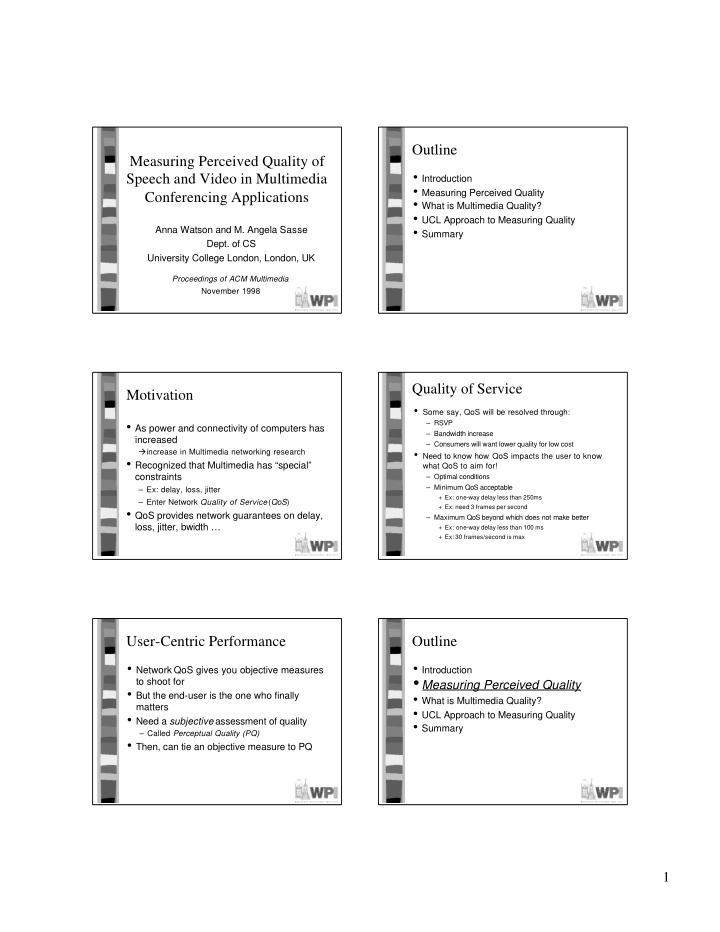



Outline Measuring Perceived Quality of • Introduction Speech and Video in Multimedia • Measuring Perceived Quality Conferencing Applications • What is Multimedia Quality? • UCL Approach to Measuring Quality Anna Watson and M. Angela Sasse • Summary Dept. of CS University College London, London, UK Proceedings of ACM Multimedia November 1998 Quality of Service Motivation • Some say, QoS will be resolved through: • As power and connectivity of computers has – RSVP – Bandwidth increase increased – Consumers will want lower quality for low cost � increase in Multimedia networking research • Need to know how QoS impacts the user to know • Recognized that Multimedia has “special” what QoS to aim for! constraints – Optimal conditions – Minimum QoS acceptable – Ex: delay, loss, jitter + Ex: one-way delay less than 250ms – Enter Network Quality of Service ( QoS ) + Ex: need 3 frames per second • QoS provides network guarantees on delay, – Maximum QoS beyond which does not make better loss, jitter, bwidth … + Ex: one-way delay less than 100 ms + Ex: 30 frames/second is max User-Centric Performance Outline • Network QoS gives you objective measures • Introduction • Measuring Perceived Quality to shoot for • But the end-user is the one who finally • What is Multimedia Quality? matters • UCL Approach to Measuring Quality • Need a subjective assessment of quality • Summary – Called Perceptual Quality (PQ) • Then, can tie an objective measure to PQ 1
ITU on Measuring Speech Quality Measuring Perceived Quality • Typically done by using standards – International Telecommunications Union (ITU) • ITU for Traditional media – Speech quality (phone, etc) – Images (television, etc) • ITU not suitable for computer based multimedia network communication • Next up: • Based on 10 second test – ITU recommended measures • Quality and Effort – Criticism • Listening ITU on Measuring Speech Criticism of ITU Speech Measure Quality • Vocabulary-based poor – “Bad”, “Poor” and “Fair” difficult to define – Clusters at the low end • Time-period is too short – Network conditions often unpredictable – Loss rates may be transient • Effort scale is too simplistic • Conversation – Again, network conditions change – Some effort for some of the talk but not all ITU on Measuring Image Quality Criticism on ITU for Images • Vocabulary not suitable – Same problems for “fair”, “poor” and “bad” – “Imperceptible” and “Perceptible” fine for television but not so good for lower-quality multimedia • Time period too short – Same 10 second test not enough • Artificiality of video test – Testing video without audio not good for multimedia • Stimulus or Impairment scales – Unlikely would be watching video with no audio 2
ITU Scale in Different International Interval Scale Languages • In English “Poor” and “Bad” seen as the same • For an international measure, labels need to – Points spaced to a 4 point, 3-interval scale be translated equally – Not 5 points, as indicated – Users avoid the end (1 and 5), so 2 points – To compare research across countries • In Italian, • Subjects given line: – no mid-point – “Worst Imaginable” at the bottom – “Ok” is equivalent to “Good” – “Best Possible” at the top • In Swedish, • Place the 5 labels on this line – “Poor” and “Bad” the same – Do we get 5 equal intervals in all languages? – “Fair” above mid-point • In Dutch, also not equal • In Japanese, all intervals equal! Outline What is Multimedia Quality? • Introduction • Not one-dimensional • Measuring Perceived Quality – 1995 telecom identified at least 4 dimensions that • What is Multimedia Quality? affect quality • Speech quality depends upon • UCL Approach to Measuring Quality – Intelligibility,loudness, naturalness, listening effort, • Summary pleasantness of tone… • Video quality depends upon – Color, brightness, background stability, speed in image reassembling… UCL Approach to Measuring What is Multimedia Quality? Quality • A one-dimensional quality view • Identify suitable vocabulary to describe quality – does not let us figure out where bottleneck is • Identify key quality dimensions – leads to one-dimensional approach to fixing • “Add more bandwidth to increase quality” • Employ knowledge in developing measure – Probably many other ways to increase quality without increasing bandwidth 3
Build Suitable Quality Identify Dimensions Vocabulary • Don’t supply words • Based on frequency of words associated with media quality – Often too technical, may be lacking • For example, “choppiness” associated with: – Ex: “Does the picture have jitter ”? • Let users describe media in own terms – Cut up – Irregular – Ex: “choppy” or “buzzy” or “static” • Build database of terms – Broken Quality Assessment Sliders Investigating New Scales (QUASS) • Unlabeled scale • Unlabeled slider – Subjects did not avoid endpoints – Consistent ratings across users • Records quality taken every second • Longer testing periods – Captures ‘instantaneous’ effects – But comparison across tests difficult • (Picture here?) – Cumulative affect on quality difficult + Instead, get last impression – Users get bored, so tests less effective • Combination of quality – Users will “forgive” bad video if followed by good – Good followed by bad is often bad + Recency effect Summary • We don’t yet know how to measure MM quality • Unlabeled scales look promising • Worry about length of tested sample – Not too short, not too long • Worry about order of samples – Avoid recency effect 4
Recommend
More recommend